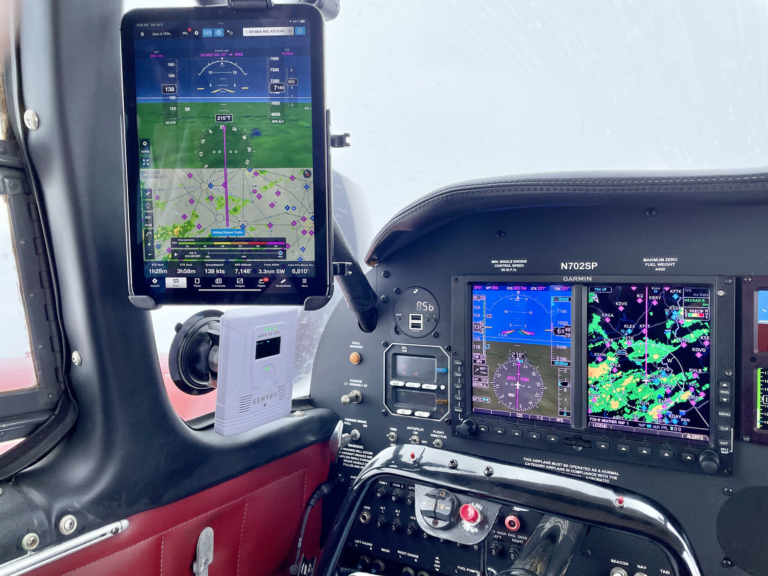
Three cheers for the iPad—an aviation miracle
iPad Pilot News
The teenage years can be awkward, as any parent can tell you (and as some of us might remember). Something similar seems to be happening to the iPad, which turns 13 this year. Dramatic advances in tablet technology have slowed down, small companies have been snapped up by major industry players, and prices have crept up. Some pilots have noticed, and started to share their frustration. One relatively new private pilot recently told me, “maybe the iPad is just a rip-off after all.”
Hardly. The iPad and aviation apps are nothing short of a miracle for pilots. They manage to make flying safer, easier, and less expensive—a rare accomplishment for technology. With a few moments of reflection, this becomes obvious.
Consider a recent cross-country IFR flight we made using the iPad. Everything was planned with ForeFlight, from the route and altitude to the weather briefing and the fuel burn calculations. In flight, we used a Sentry Plus ADS-B Receiver to keep an eye on weather and traffic, making deviations as needed and updating our plan along the way. The end result was a routine flight and happy passengers.
The tools required and the money spent to accomplish this trip were surprisingly small. In the flight bag:
- iPad mini 6 (essentially a screen with a battery here) – $649
- ForeFlight Pro Plus subscription (charts, airport directory, flight planning, navigation, checklists, and so much more) – $240
- Sentry Plus ADS-B Receiver (weather, traffic, GPS, AHRS, CO detector) – $799
- RAM iPad Mount – $74.95
Total cost for my digital flight bag: $1522.95 plus $240/year.
Consider that the iPad can also be used for a host of non-aviation applications, from email and work documents to family photos and games for the kids, and the value is even more impressive. This multi-function ability makes the iPad my everyday companion, and it does help with spousal approval in some cases—a tablet is probably more useful for the rest of the family that a panel-mount GPS.
Now let’s recreate this flight back in 2010, when the iPad came out—I did it hundreds of times myself and I can confirm that flying was indeed possible before ForeFlight. But I remember it being more difficult and more expensive. A quick browse through the Sporty’s Pilot Shop catalog archives provided some real numbers. Here is a comparable flight bag, pre-iPad.
Charts:
- Sectionals – $9.05 X 5 charts for this route (updated twice per year) = $90.50/year
- En route low altitude – $4.70 X 4 charts (updated six times per year) = $112.80/year
- Approach plates – $5.30 x 7 charts (updated six times per year) = $222.60/year
- Airport/facility directory – $4.80 x 3 charts (updated six times per year) = $86.40/year
- Chart plotters, binders, kneeboard – $95, one time.
Navigation and weather:
- Garmin GPSMAP 696 (moving map, airport directory, terrain) – $2999
- XM Weather subscription (in-flight weather) – $50/month
- Zaon XRX (portable traffic system—limited, but the only real option in 2010) – $1495
- Electronic CO detector – $179
Paperwork and planning:
- Electronic E6B – $69.95
- Digital logbook program (for Windows) – $69.95
- Books and documents – it varies, but easily $100
Total cost for my non-iPad flight bag: $5007.90 plus $1112.30/year.
So the pre-iPad equipment was more than three times as expensive, and the subscription was nearly five times as expensive. That $3500 in up-front savings would easily pay for an ADS-B Out upgrade or a Garmin G5 instrument. That annual savings of nearly $900 would pay for roughly 150 gallons of avgas, enough for 10-20 hours of flying in most piston airplanes. And of course none of those 2010 numbers take inflation into account (in 2022 dollars, the Garmin 696 would be over $4000).
Perhaps more importantly, the new equipment is not only cheaper but better: there was no backup attitude display on the Garmin, no seamless chart planning, no synthetic vision, no flight data recorder, no automatic winds aloft planning tool before flight. My iPad lasts over five hours and recharges off a standard USB port; my old 696 lasted maybe three hours and used a proprietary cable. ADS-B traffic in ForeFlight shows other airplanes’ speed, track, and relative altitude (complete with audio alerts); my old Zaon only showed which quadrant to look for an airplane, and even that wasn’t too accurate. ForeFlight updates every chart in America in about 10 minutes; doing Jepp updates used to take half a day.
The iPad and electronic flight bag apps are not perfect. Just last week Garmin Pilot crashed the first two times I tried to open the app, ForeFlight has raised their prices recently, and Fltplan Go occasionally has maddening user interface choices. That means pilots should continue to voice their displeasure when they believe companies aren’t holding up their end of the deal (as I have and will continue to do). But we should also maintain some perspective, and recognize what amazing technology we get to fly with in 2023. In terms of cockpit technology, the good old days are right now.
Or as a famous comedian once said in a slightly off-color way, “everything is amazing right now and nobody is happy.”
The post Three cheers for the iPad—an aviation miracle appeared first on iPad Pilot News.
Source: Ipad appsThree cheers for the iPad—an aviation miracle

